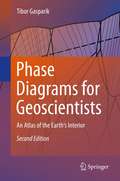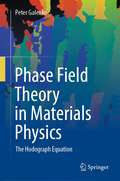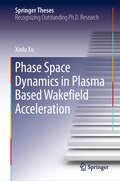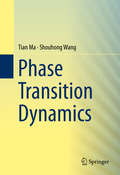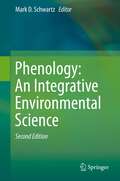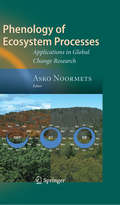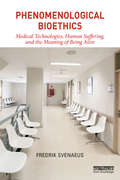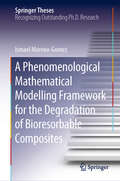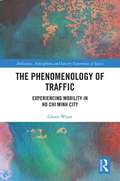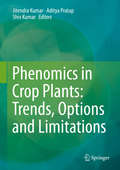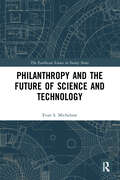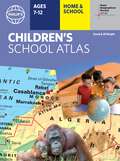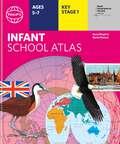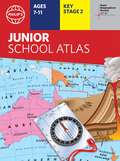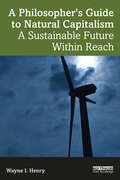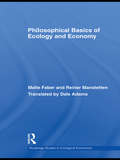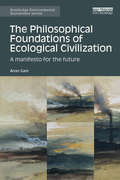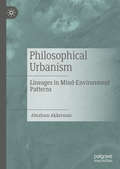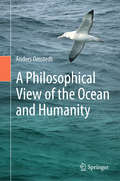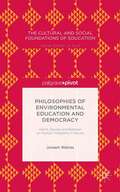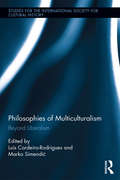- Table View
- List View
Phase Diagrams for Geoscientists: An Atlas of the Earth's Interior
by Tibor GasparikThe book summarizes the results of the experimental studies of phase relations in the chemical systems relevant to Earth, carried out by the author in a time period of over 20 years between 1979 and 2001. It is based on 1000 piston-cylinder experiments at pressures up to 4 GPa, and close to 700 experiments carried out with a multi-anvil apparatus at pressures up to 24 GPA. This is the largest published collection of calculated phase diagrams for the chemical systems relevant to Earth. This is also the first time that the phase relations at the relatively low pressures of the lithospheric mantle, mainly applicable to the experimental thermobarometry of metamorphic rocks and mantle xenoliths, are seamlessly integrated with the phase relations of the sublithospheric upper mantle and the uppermost lower mantle, primarily applicable to inclusions in diamond and schocked meteorites. "Tibor Gasparik has devoted his career to determining the high-pressure, high-temperature phase relations of the geologically important Sodium-Calcium-Magnesium-Aluminium-Silicon (NCMAS) oxide system. This book is his opus magnum, summarizing more than 1700 experiments in over 120 figures. ... I have found Phase Diagrams for Geoscientists to be a useful first port-of-call for finding the P-T stability fields ... and I can recommend the book as a reference for geoscientists requiring an overview of the stable phase assemblages in the top 700 km of the Earth." (David Dobson, Geological Magazine, Vol. 142 (2), 2005)
Phase Field Theory in Materials Physics: The Hodograph Equation
by Peter GalenkoThis book deals with the use of the hodograph equation in phase transformations in condensed matter, especially, for crystallization and solidification processes. The main focus of the book is the interpretation of the phase-field equations for isotropic and anisotropic interfaces based on the advanced Gibbs–Thomson and Herring conditions, respectively. Beginning with the basic ideas behind the extended irreversible thermodynamics, the kinetic phase-field model for slow and arbitrarily fast phase transformations is derived where the unified hodograph equation follows from:• the sharp interface limit of the diffuse interface or• the traveling wave solution of the propagating phase field.Under the example of solute trapping and disorder trapping effects, comparing theoretical results with molecular dynamics simulations, and with the analysis of experimental data, the concrete workability of the developed hodograph equation is demonstrated for widest range of driving force in phase transformations.
Phase Space Dynamics in Plasma Based Wakefield Acceleration (Springer Theses)
by Xinlu XuThis book explores several key issues in beam phase space dynamics in plasma-based wakefield accelerators. It reveals the phase space dynamics of ionization-based injection methods by identifying two key phase mixing processes. Subsequently, the book proposes a two-color laser ionization injection scheme for generating high-quality beams, and assesses it using particle-in-cell (PIC) simulations. To eliminate emittance growth when the beam propagates between plasma accelerators and traditional accelerator components, a method using longitudinally tailored plasma structures as phase space matching components is proposed. Based on the aspects above, a preliminary design study on X-ray free-electron lasers driven by plasma accelerators is presented. Lastly, an important type of numerical noise—the numerical Cherenkov instabilities in particle-in-cell codes—is systematically studied.
Phase Transition Dynamics
by Tian Ma Shouhong WangThis book is an introduction to a comprehensive and unified dynamic transition theory for dissipative systems and to applications of the theory to a range of problems in the nonlinear sciences. The main objectives of this book are to introduce a general principle of dynamic transitions for dissipative systems, to establish a systematic dynamic transition theory, and to explore the physical implications of applications of the theory to a range of problems in the nonlinear sciences. The basic philosophy of the theory is to search for a complete set of transition states, and the general principle states that dynamic transitions of all dissipative systems can be classified into three categories: continuous, catastrophic and random. The audience for this book includes advanced graduate students and researchers in mathematics and physics as well as in other related fields.
Phase Transitions in Materials
by Brent FultzOffering a fresh viewpoint on phase changes and the thermodynamics of materials, this textbook covers the thermodynamics and kinetics of the most important phase transitions in materials science, spanning classical metallurgy through to nanoscience and quantum phase transitions. Clear, concise and complete explanations rigorously address transitions from the atomic scale up, providing the quantitative concepts, analytical tools and methods needed to understand modern research in materials science. Topics are grouped according to complexity, ensuring that students have a solid grounding in core topics before they begin to tackle more advanced material, and are accompanied by numerous end-of-chapter problems. With explanations firmly rooted in the context of modern advances in electronic structure and statistical mechanics, and developed from classroom teaching, this book is the ideal companion for graduate students and researchers in materials science, condensed matter physics, solid state science, and physical chemistry.
Phenology: An Integrative Environmental Science
by Mark D. SchwartzPhenology refers to recurring plant and animal life cycle stages, such as leafing and flowering, maturation of agricultural plants, emergence of insects, and migration of birds. It is also the study of these recurring events, especially their timing and relationships with weather and climate. Phenological phenomena all give a ready measure of the environment as viewed by the associated organism, and are thus ideal indicators of the impact of local and global changes in weather and climate on the earth's biosphere. Assessing our changing world is a complex task that requires close cooperation from experts in biology, climatology, ecology, geography, oceanography, remote sensing, and other areas. Like its predecessor, this second edition of Phenology is a synthesis of current phenological knowledge, designed as a primer on the field for global change and general scientists, students, and interested members of the public. With updated and new contributions from over fifty phenological experts, covering data collection, current research, methods, and applications, it demonstrates the accomplishments, progress over the last decade, and future potential of phenology as an integrative environmental science.
Phenology of Ecosystem Processes
by Asko NoormetsTerrestrial carbon balance is uncertain at the regional and global scale. A significant source of variability in mid-latitude ecosystems is related to the timing and duration of phenological phases. Spring phenology, in particular, has disproportionate effects on the annual carbon balance. However, the traditional phenological indices that are based on leaf-out and flowering times of select indicator species are not universally amenable for predicting the temporal dynamics of ecosystem carbon and water exchange. Phenology of Ecosystem Processes evaluates current applications of traditional phenology in carbon and H2O cycle research, as well as the potential to identify phenological signals in ecosystem processes themselves. The book summarizes recent progress in the understanding of the seasonal dynamics of ecosystem carbon and H2O fluxes, the novel use of various methods (stable isotopes, time-series, forward and inverse modeling), and the implications for remote sensing and global carbon cycle modeling. Each chapter includes a literature review, in order to present the state-of-the-science in the field and enhance the book's usability as an educational aid, as well as a case study to exemplify the use and applicability of various methods. Chapters that apply a specific methodology summarize the successes and challenges of particular methods for quantifying the seasonal changes in ecosystem carbon, water and energy fluxes. The book will benefit global change researchers, modelers, and advanced students.
Phenomenological Bioethics: Medical Technologies, Human Suffering, and the Meaning of Being Alive
by Fredrik SvenaeusEmerging medical technologies are changing our views on human nature and what it means to be alive, healthy, and leading a good life. Reproductive technologies, genetic diagnosis, organ transplantation, and psychopharmacological drugs all raise existential questions that need to be tackled by way of philosophical analysis. Yet questions regarding the meaning of life have been strangely absent from medical ethics so far. This book brings phenomenology, the main player in the continental tradition of philosophy, to bioethics, and it does so in a comprehensive and clear manner. Starting out by analysing illness as an embodied, contextualized, and narrated experience, the book addresses the role of empathy, dialogue, and interpretation in the encounter between health-care professional and patient. Medical science and emerging technologies are then brought to scrutiny as endeavours that bring enormous possibilities in relieving human suffering but also great risks in transforming our fundamental life views. How are we to understand and deal with attempts to change the predicaments of coming to life and the possibilities of becoming better than well or even, eventually, surviving death? This is the first book to bring the phenomenological tradition, including philosophers such as Martin Heidegger, Edith Stein, Maurice Merleau-Ponty, Jean-Paul Sartre, Hans-Georg Gadamer, Paul Ricoeur, Hans Jonas, and Charles Taylor, to answer such burning questions.
A Phenomenological Mathematical Modelling Framework for the Degradation of Bioresorbable Composites (Springer Theses)
by Ismael Moreno-GomezThis book presents a generalised computational model for the degradation of resorbable composites, using analytic expressions to represent the interwoven phenomena present during degradation. It then combines this modelling framework with a comprehensive database of quantitative degradation data mined from existing literature and from novel experiments, to provide new insights into the interrelated factors controlling degradation. Resorbable composites made of biodegradable polyesters and calcium-based ceramics have significant therapeutic potential as tissue engineering scaffolds, as temporary implants and as drug-loaded matrices for controlled release. However, their degradation is complex and the rate of resorption depends on multiple connected factors such as the shape and size of the device, polymer chemistry and molecular weight, particle phase, size, volume fraction, distribution and pH-dependent dissolution properties. Understanding and ultimately predicting the degradation of resorbable composites is of central importance if we are to fully unlock the promise of these materials.
The Phenomenology of Traffic: Experiencing Mobility in Ho Chi Minh City (Ambiances, Atmospheres and Sensory Experiences of Spaces)
by Glenn WyattThe book delves into the affective, embodied, and sensory dimensions of traffic and urban mobility. It brings together key phenomenological and post-phenomenological readings to challenge taken for granted assumptions of urban traffic. Through the experiences of traffic users in Ho Chi Minh City, Vietnam, the book provides fascinating pathways into structures and processes that make up phenomenal traffic worlds. It explores the nature of the traffic experience, modalities of existence within it, and the wide spectrum of awarenesses involved in making sense from non-sense. The book offers rich theoretical insights on how we feel our way through our affect-laden worlds. Through empirical examples from the urban traffic in Ho Chi Minh City, the book explores this fluid, constantly changing complex collective of ongoing negotiations we call ‘traffic,’ often emotional, involving and producing all kinds of entities. It develops a range of philosophical concepts in order to better understand the complex relationships between humans and non-humans in everyday settings. Offering innovative insights into the structures, authorities, materialities and forms of power that shape our experiences of traffic, this book will be of interest to students, scholars and practitioners interested in philosophy, cultural geography, mobilities, transport studies, cultural studies, and urban studies.
Phenomics in Crop Plants: Trends, Options and Limitations
by Jitendra Kumar Aditya Pratap Shiv KumarIdentification of desirable genotypes with traits of interest is discernible for making genetic improvement of crop plants. In this direction, screening of a large number of germplasm for desirable traits and transfer of identified traits into agronomic backgrounds through recombination breeding is the common breeding approach. Although visual screening is easier for qualitative traits, its use is not much effective for quantitative traits and also for those, which are difficult to score visually. Therefore, it is imperative to phenotype the germplasm accessions and breeding materials precisely using high throughput phenomics tools for challenging and complex traits under natural, controlled and harsh environmental conditions. Realizing the importance of phenotyping data towards identification and utilization of a germplasm as donors, global scientific community has exerted increased focus on advancing phenomics in crop plants leading to development of a number of techniques and methodologies for screening of agronomic, physiological, and biochemical traits. These technologies have now become much advanced and entered the era of digital science. This book provides exhaustive information on various aspects related to phenotyping of crop plants and offers a most comprehensive reference on the developments made in traditional and high throughput phenotyping of agricultural crops.
Philanthropy and the Future of Science and Technology (The Earthscan Science in Society Series)
by Evan S. MichelsonAn increasingly important and often overlooked issue in science and technology policy is recognizing the role that philanthropies play in setting the direction of research. In an era where public and private resources for science are strained, the practices that foundations adopt to advance basic and applied research needs to be better understood. This first-of-its-kind study provides a detailed assessment of the current state of science philanthropy. This examination is particularly timely, given that science philanthropies will have an increasingly important and outsized role to play in advancing responsible innovation and in shaping how research is conducted. Philanthropy and the Future of Science and Technology surveys the landscape of contemporary philanthropic involvement in science and technology by combining theoretical insights drawn from the responsible research and innovation (RRI) framework with empirical analysis investigating an array of detailed examples and case studies. Insights from interviews conducted with foundation representatives, scholars, and practitioners from a variety of sectors add real-world perspective. A wide range of philanthropic interventions are explored, focusing on support for individuals, institutions, and networks, with attention paid to the role that science philanthropies play in helping to establish and coordinate multi-sectoral funding partnerships. Novel approaches to science philanthropy are also considered, including the emergence of crowdfunding and the development of new institutional mechanisms to advance scientific research. The discussion concludes with an imaginative look into the future, outlining a series of lessons learned that can guide how new and established science philanthropies operate and envisioning alternative scenarios for the future that can inform how science philanthropy progresses over the coming decades. This book offers a major contribution to the advancement of philanthropic investment in science and technology. Thus, it will be of considerable interest to researchers and students in public policy, public administration, political science, science and technology studies, sociology of science, and related disciplines.
Philip's RGS Children's School Atlas (Philip's World Atlas #26)
by David Wright Jill Wright Philip's Maps Rachel Noonan"This is such a great book for primary school age children and a little beyond for finding out about the world, its countries and people" Amazon customer review- Philip's atlas, designed specially to use at home and at school with guidance for parents and teachers- Clear maps and fascinating facts bring geography to life for readers aged 7-12- Published by Philip's the UK's leading school atlas publisher, in association with the Royal Geographical Society- Quizzes, activity ideas and puzzles to make learning fun- Past winner of the Geographical Association's award for making a significant contribution to geographyThe atlas is organized spread by spread in the classic sequence: first Europe, then its land neighbour Asia, followed by Africa, Australia and Oceania, North America and South America.Illustrated with captivating full-colour photographs and packed with fact boxes, curiosities, flags, stamps and quiz questions, Philip's RGS Children's Atlas is both fun to use and easy to understand.Now in its 16th edition, Philip's RGS Children's Atlas is a past winner of the Geographical Association's award for making a significant contribution to geography. The atlas was judged "an excellent 'all round' children's atlas with simple yet well-designed maps, well-illustrated with colour photographs. It links places to issues, events and real people, giving a clear sense of place."
Philip's RGS Children's School Atlas (Philip's World Atlas #26)
by David Wright Jill Wright Philip's Maps Rachel Noonan"This is such a great book for primary school age children and a little beyond for finding out about the world, its countries and people" Amazon customer review- Philip's atlas, designed specially to use at home and at school with guidance for parents and teachers- Clear maps and fascinating facts bring geography to life for readers aged 7-12- Published by Philip's the UK's leading school atlas publisher, in association with the Royal Geographical Society- Quizzes, activity ideas and puzzles to make learning fun- Past winner of the Geographical Association's award for making a significant contribution to geographyThe atlas is organized spread by spread in the classic sequence: first Europe, then its land neighbour Asia, followed by Africa, Australia and Oceania, North America and South America.Illustrated with captivating full-colour photographs and packed with fact boxes, curiosities, flags, stamps and quiz questions, Philip's RGS Children's Atlas is both fun to use and easy to understand.Now in its 16th edition, Philip's RGS Children's Atlas is a past winner of the Geographical Association's award for making a significant contribution to geography. The atlas was judged "an excellent 'all round' children's atlas with simple yet well-designed maps, well-illustrated with colour photographs. It links places to issues, events and real people, giving a clear sense of place."
Philip's RGS Infant's School Atlas (Philip's World Atlas #27)
by David Wright Jill Wright Philip's MapsWritten for 5 to 7 year-old this atlas is ideal for teaching Key Stage 1, helping to cover geography, history, science, citizenship and literacy requirements- Written by experts Professor David Wright and Rachel Noonan- Published in association with the Royal Geographical Society- 50 pages of clear, child-friendly maps showing our world today- Countries of the world brought to life with flags, illustrations and photos- Bold text, simple words and short sentences to encourage reading skills- Starts with the Earth as a Planet then zooms into each of the world's regions with maps and illustrations- Numbered balloons on each map link to photos of a real placeFully revised and updated, the atlas is for children aged 5-7 in the early stages of reading, with simple text to explain what is happening on the maps and illustrations - all compatible with National Curriculum Key Stage 1.Clear, child-friendly maps are combined with vibrant photographs and facts about the world to provide essential geographical information for young children. Guidance is given at the beginning of the atlas on how to use the maps, encouraging the early development of map skills and knowledge of the world. Each colourful spread is illustrated with photographs and packed with fact boxes, curiosities, flags, stamps and simple quiz questions. Philip's RGS Infant School Atlas is both fun to use and easy to understand. The text is simple and uncomplicated to encourage early reading skills.
Philip's RGS Infant's School Atlas (Philip's World Atlas #27)
by David Wright Jill Wright Philip's MapsWritten for 5 to 7 year-old this atlas is ideal for teaching Key Stage 1, helping to cover geography, history, science, citizenship and literacy requirements- Written by experts Professor David Wright and Rachel Noonan- Published in association with the Royal Geographical Society- 50 pages of clear, child-friendly maps showing our world today- Countries of the world brought to life with flags, illustrations and photos- Bold text, simple words and short sentences to encourage reading skills- Starts with the Earth as a Planet then zooms into each of the world's regions with maps and illustrations- Numbered balloons on each map link to photos of a real placeFully revised and updated, the atlas is for children aged 5-7 in the early stages of reading, with simple text to explain what is happening on the maps and illustrations - all compatible with National Curriculum Key Stage 1.Clear, child-friendly maps are combined with vibrant photographs and facts about the world to provide essential geographical information for young children. Guidance is given at the beginning of the atlas on how to use the maps, encouraging the early development of map skills and knowledge of the world. Each colourful spread is illustrated with photographs and packed with fact boxes, curiosities, flags, stamps and simple quiz questions. Philip's RGS Infant School Atlas is both fun to use and easy to understand. The text is simple and uncomplicated to encourage early reading skills.
Philip's RGS Junior School Atlas (Philip's World Atlas #28)
by Philip's MapsThe 11th edition of the market-leading atlas for primary school pupils, Philip's RGS Junior School Atlas has been fully revised and updated with all the latest facts and curriculum requirements. - The essential atlas for primary schools with clear and easy-to-follow maps and diagrams - updated for 2021/22- Published in association with the Royal Geographical Society- Recommended for Key Stage 2 of the National Curriculum - and all 7-11 year olds - An excellent introduction to mapping concepts such as scale, direction, symbols, longitude and latitude- 22-page Britain and Ireland section with clear thematic charts, diagrams and large-scale regional maps- 22-page section on The World, with political maps - and thematic treatment of key themes, from volcanoes and earthquakes to transport and tourism- Continents section with physical and political maps- Easy-to-follow map references and 1,000-place indexThe market-leading atlas for pupils at primary schools, Philip's RGS Junior School Atlas is a stimulating and authoritative first introduction to the world of maps, and is recommended for Key Stage 2 of the National Curriculum.The introductory section describes the meaning of scale, how to measure distances using the maps, and explains the symbols on the maps.The following section is devoted to the United Kingdom and Ireland. Thematic maps cover topics such as mountains and rivers, climate and weather, population and cities, farming and fishing, industry and energy, transport, tourism and conservation. Regional maps of England and Wales, Scotland and Ireland complete this section.The rest of the atlas is made up of world thematic maps and world continental maps. Included are topics such as the world's climate, vegetation, agriculture, energy sources, and environmental concerns, such as global warming. A simple letter-figure index completes the atlas - a useful introduction to help the young reader find his/her way around the maps. Available in both hardback and paperback editions.
Philip's RGS Junior School Atlas (Philip's World Atlas #28)
by Philip's MapsThe 11th edition of the market-leading atlas for primary school pupils, Philip's RGS Junior School Atlas has been fully revised and updated with all the latest facts and curriculum requirements. - The essential atlas for primary schools with clear and easy-to-follow maps and diagrams - updated for 2021/22- Published in association with the Royal Geographical Society- Recommended for Key Stage 2 of the National Curriculum - and all 7-11 year olds - An excellent introduction to mapping concepts such as scale, direction, symbols, longitude and latitude- 22-page Britain and Ireland section with clear thematic charts, diagrams and large-scale regional maps- 22-page section on The World, with political maps - and thematic treatment of key themes, from volcanoes and earthquakes to transport and tourism- Continents section with physical and political maps- Easy-to-follow map references and 1,000-place indexThe market-leading atlas for pupils at primary schools, Philip's RGS Junior School Atlas is a stimulating and authoritative first introduction to the world of maps, and is recommended for Key Stage 2 of the National Curriculum.The introductory section describes the meaning of scale, how to measure distances using the maps, and explains the symbols on the maps.The following section is devoted to the United Kingdom and Ireland. Thematic maps cover topics such as mountains and rivers, climate and weather, population and cities, farming and fishing, industry and energy, transport, tourism and conservation. Regional maps of England and Wales, Scotland and Ireland complete this section.The rest of the atlas is made up of world thematic maps and world continental maps. Included are topics such as the world's climate, vegetation, agriculture, energy sources, and environmental concerns, such as global warming. A simple letter-figure index completes the atlas - a useful introduction to help the young reader find his/her way around the maps. Available in both hardback and paperback editions.
A Philosopher's Guide to Natural Capitalism: A Sustainable Future Within Reach
by Wayne I. HenryThis book posits that a sustainable future is possible without abandoning Capitalism. In its current form as Consumer Capitalism, the organization of the global economy is clearly unsustainable. But Capitalism is a malleable concept that has assumed a variety of forms since the 17th century, and it can be altered as needed. In Part I of this book, the author sets out an economic model for a sustainable form of Capitalism, referred to in the literature as Natural Capitalism. In Part II, he abandons exposition in favour of rigorous philosophical analysis and critiques the older but still dominant narrative that underlies Classical Liberalism. The narrative will be reconstructed with great care and analysed to understand why it has been so powerful and enduring, and, of course, why it is no longer appropriate for our current circumstances. In Part III, he investigates from a normative perspective Classical Liberalism and globalized Capitalism and the economic system it licenses. Finally, in the conclusion, the author draws the threads of the discussion together in a way that emphasizes the differences between the two narratives, Classical Liberalism on the one hand and the contemporary version of Progressive Liberalism that nurtures and supports Natural Capitalism on the other. This book will be of interest to a broad range of scholars and curious laypersons interested in a clear and interdisciplinary presentation of the issues arising out of climate change, including corporate governance, social and environmental policy, declining social capital and the capacity of democratic institutions to deal effectively with sustainability. It will be particularly relevant for students and instructors of philosophy, history, economics, political science, social policy and environmental sociology.
Philosophical Basics of Ecology and Economy (Routledge Studies In Ecological Economics Ser.)
by Malte Faber Reiner ManstettenIn today's world – despite the dramatic anthropogenic environmental changes – a proper understanding of the relationship between humanity and nature requires a certain detachment. The pressing problems in their whole extent will only be fully understood and solved with comprehensive and patient analysis. Accordingly, this book develops new perspectives on fundamental questions of biology, ecology, and the economy, integrated within a framework of a terminology specially devised by the authors. By illuminating the epistemological backgrounds of ecological-economic research, the authors lay foundations for interdisciplinary environmental research and offer guidelines for practical action. In close contact to the findings of present-day biology and economics, they demonstrate the fruitfulness as well as the shortcomings of modern science for the understanding of the proper place of humankind in nature. Many of the book's central concepts are rooted in a tradition whose origins go back to European philosophy and literature of the 17th Century. Frequently current problems in the fields of economics, ecology, politics, philosophy and biology are discussed in a kind of "dialogue" with thinkers and poets like Bacon, Quesnay, Kant, Goethe and Novalis. This approach of the book, known in Continental European Philosophy as hermeneutics, offers a ‘map’, rather than marking out a specific course. On the other hand, the book offers traits of the Anglo-Saxon tradition of thought: a precise, analytical approach to theory and a pragmatic approach to action. Both approaches are used by the authors complementarily. Thus the authors lay the foundations for an ecological economical and political practice which is able to tackle concrete environmental problems on an encompassing and long-term basis. This translated volume will be of great use and interest to students of ecology, economics and in particular environmental education, sustainable development and environmental ethics.
The Philosophical Foundations of Ecological Civilization: A manifesto for the future (Routledge Environmental Humanities)
by Arran GareThe global ecological crisis is the greatest challenge humanity has ever had to confront, and humanity is failing. The triumph of the neo-liberal agenda, together with a debauched ‘scientism’, has reduced nature and people to nothing but raw materials, instruments and consumers to be efficiently managed in a global market dominated by corporate managers, media moguls and technocrats. The arts and the humanities have been devalued, genuine science has been crippled, and the quest for autonomy and democracy undermined. The resultant trajectory towards global ecological destruction appears inexorable, and neither governments nor environmental movements have significantly altered this, or indeed, seem able to. The Philosophical Foundations of Ecological Civilization is a wide-ranging and scholarly analysis of this failure. This book reframes the dynamics of the debate beyond the discourses of economics, politics and techno-science. Reviving natural philosophy to align science with the humanities, it offers the categories required to reform our modes of existence and our institutions so that we augment, rather than undermine, the life of the ecosystems of which we are part. From this philosophical foundation, the author puts forth a manifesto for transforming our culture into one which could provide an effective global environmental movement and provide the foundations for a global ecological civilization.
Philosophical Urbanism: Lineages in Mind-Environment Patterns
by Abraham AkkermanThis book expands on the thought of Walter Benjamin by exploring the notion of modern mind, pointing to the mutual and ongoing feedback between mind and city-form. Since the Neolithic Age, volumes and voids have been the founding constituents of built environments as projections of gender—as spatial allegories of the masculine and the feminine. While these allegories had been largely in balance throughout the early history of the city, increasingly during modernity, volume has overcome void in city-form. This volume investigates the pattern of Benjamin's thinking and extends it to the larger psycho-cultural and urban contexts of various time periods, pointing to environ/mental progression in the unfolding of modernity.
A Philosophical View of the Ocean and Humanity (Springerbriefs In Environmental Science Ser.)
by Anders OmstedtThis book is about the ocean and about the future. It is written in two modes, a concerned analytical scientific mode and an intuitive artistic mode in which the ocean is given a voice. The disconnect in the relationship between human dependency on and feelings about the ocean is examined in a dialogue between these two modes. The book illustrates how science and the arts can be connected to increase our awareness of the state of the ocean and support behavioural change. This book is intended for everyone who would like to contribute to the sustainable use of the ocean. Includes forewords by Alice Newton, University of Algarve, Portugal and Martin Visbeck, GEOMAR, Helmholtz Centre for Ocean Research, Kiel, Germany.
Philosophies of Environmental Education and Democracy: Harris, Dewey, and Bateson on Human Freedoms in Nature
by Joseph WatrasThe project examines how three prominent philosophers of education - William Torrey Harris, John Dewey, and Gregory Bateson - each developed a world view that provides a philosophical basis for environmental education.
Philosophies of Multiculturalism: Beyond Liberalism (Studies for the International Society for Cultural History #9)
by Luis Cordeiro-Rodrigues Marko SimendicThis edited collection offers a comparative approach to the topic of multiculturalism, including different authors with contrasting arguments from different philosophical traditions and ideologies. It puts together perspectives that have been largely neglected as valid normative ways to address the political and moral questions that arise from the coexistence of different cultures in the same geographical space. The essays in this volume cover both historical perspectives, taking in the work of Hobbes, Tocqueville and Nietzsche among others, and contemporary Eastern and Western approaches, including Marxism, anarchism, Islam, Daoism, Indian and African philosophies.
